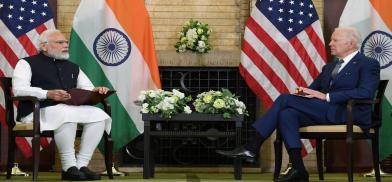Modi’s state visit to the US: Its significance for Indo-US ties and global politics
The centerpiece of Modi’s state visit to the US is expected to be a jet engine agreement that can propel Indo-US relations to a new sphere altogether. The application by General Electric to co-produce GE-F414 jet engines in India, along with technology transfer, has already received approval of the Biden administration.

Indian Prime Minister Narendra Modi’s first state visit to the United States from June 21 to June 24 at the invitation of President Joe Biden has attracted great attention and discussion. State visits are widely recognized as the pinnacle of bilateral relations, marked by a series of formal public ceremonies. The upcoming visit has created new hope for a renewed friendship between the world’s oldest and world’s largest democracy amid growing geopolitical tension and ever-changing global dynamics.
Interestingly, this visit will be the third state visit from India to the US. But what makes this visit more special is that PM Modi will address the US Congress for the second time after his 2016 speech which is very rare for foreign leaders. It really shows the importance the US gives to a stable and friendly relationship with India. Moreover, given the recent political developments regarding the Indian stand on the Russia-Ukraine war and geopolitical competition in the Indo-Pacific, the Indo-US bilateral relations has become a subject of global interest. Experts believe this visit will help both countries address their differences while deepening their cooperation in strategic sectors to rebuild a relationship of trust and confidence without compromising too much of their national interests and foreign policy objectives.
Context and dynamics of Indo-US relations
The US and India share deep historical ties which date back to 1492 when Christopher Columbus accidentally discovered America in his search for a new sea route to India. Both countries established their diplomatic ties after the 1947 division which saw the birth of two countries, India and Pakistan. Although the US historically maintained good relations with India, it always preferred Pakistan as its close ally in the region. However, over the years, the scenario has changed completely as the US has upgraded its relations with India to a “strategic partnership”, whereas Pakistan has now close strategic ties with China. The US is already the largest trading partner of India and the trade volume reached a record $157 billion in 2021. There are more than 50 bilateral dialogue mechanisms between the two governments. With the US’s geostrategic shift from Euro-Atlantic to Indo-Pacific, the strategic relations between the two nations reached a new high unlike ever before.
India is the largest nation in South Asia. It has a long coastline in the Bay of Bengal, which connects it to the Indian Ocean, a theater of geostrategic power competition in the 21st century. India has emerged as the most populous nation in the world overcoming China for the first time with a population of 1.428 billion, which is nearly one-fifth of the global population. Given India’s demographic dividend with a 650 million strong youth population, its economy is projected to be the third-largest in the world by 2027. These factors indicate that India is a powerful nation that can maneuver its foreign policy without external influence. One can see that in some recent policies of India that do not subscribe to the interests of the US.
The silence of India on the Russia-Ukraine war has not made the US too happy. The US wanted India on its side like its European allies in condemning Russia for invading a sovereign nation by putting sanctions and other harsh diplomatic measures. However, India chose to maintain a balanced position, where it has continued with its strategy of not criticizing Russia directly. For instance, India once again abstained from voting during the latest UNGA resolution condemning the Russian invasion of Ukraine. Most importantly, India has emerged as the top importer of Russian energy despite Western sanctions.
Likewise, the US wants India to be its most trusted partner in the Indo-Pacific as a counterweight to China. However, India is trying to be a net security provider in the region, while maintaining an independent foreign policy posture. Besides, the US has also raised concerns about ethnic polarization and minority oppression in India.
There has been in recent months a flurry of high-level visits and meetings between the two countries to bridge the perception gap. Both leaders were scheduled to meet four times in just two months this year. However, President Biden skipped the India-Pacific Islands Cooperation meeting, and the QUAD summit in Australia was canceled; so the number of meetings was reduced to two. Both leaders have already met on the sidelines of the G7 summit in Japan in May. In preparation for Modi’s state visit, US Defense Secretary Lloyd Austin and National Security Adviser Jake Sullivan came to India on a two-day visit. President Biden is scheduled to visit India to attend the G20 summit in September this year.
Potential impact of Modi’s visit
A state visit to the US is distinct from official or working visits as a country is typically granted only one state visit during a US president's four-year tenure. President Biden has thus far had a single state visit in December 2022 when he hosted French President Emanuel Macron. The forthcoming visit holds immense potential for Indo-US relations and has been compared to Prime Minister Manmohan Singh's previous state visit in 2009, during which the two countries announced the groundbreaking nuclear deal despite US’s political reservations and concerns from its allies. This time around both countries are looking to take a big leap in strengthening bilateral defense cooperation, especially in the areas of the transfer of critical technologies for the co-development of military hardware. In the age of information technology, collaboration in critical and emerging technologies is just as important as the nuclear deal.
Consequential jet engine deal
The centerpiece of Modi’s state visit to the US is expected to be a jet engine agreement that can propel Indo-US relations to a new sphere altogether. The application by General Electric to co-produce GE-F414 jet engines in India, along with technology transfer, has already received approval of the Biden administration. The administration views the GE deal as an unprecedented proposition, serving as a strategic move by the White House to ensure the continued positive trajectory of US-India relations. Jet engine technology is highly coveted and holds great significance, with only three other countries—Britain, France, and Russia—currently possessing it. By entering into this agreement, India will join the exclusive group of nations with access to this advanced technology, which will undoubtedly provide a substantial diplomatic boost.
The US declared India as a ‘major defense partner’ in 2016. The two countries have inked key defense and security pacts over the past few years, including the Logistics Exchange Memorandum of Agreement (LEMOA) in 2016, Communications Compatibility and Security Agreement (COMCASA) in 2018, Basic Exchange and Cooperation Agreement (BECA) in 2020, and Critical and Emerging Technology (iCET) in 2022. However, the potential jet-engine agreement outperforms all previous deals. This agreement has the potential to help India achieve its goal of becoming “Atmanirbhar” which is attaining self-reliance, particularly in defense production, following the Russia-Ukraine conflict which highlighted India's heavy reliance on Russia for weaponry that now finds itself outdated. On the other hand, for the US, by sharing this sensitive military technology with India, it wants to convey a strong message that the US is ready to do everything to boost mutual trust and confidence between the two nations. As US Ambassador to India, Eric Garcetti said, “We have not done this (jet engine agreement) for some of our closest allies. So India is accorded a depth of friendship and a strategic partnership.”
A strong partnership will in turn help the US secure India’s support in its Indo-Pacific endeavor to check Chinese growing assertiveness in the region. Political scientist Sumit Ganguly said, “The Biden administration is desperately courting India – they need a potential counterweight to China, for global supply chain and investment reasons.” State Department's Deputy Press Secretary Vedant Patel told in a press conference that the US’s partnership with India is one of its most consequential relationships and the visit will further strengthen their partnership in ensuring a free and open Indo-Pacific in relation to Chinese aggressive behavior in the region. In addition, White House spokesperson Karine Jean-Pierre said, “The visit will strengthen our two countries’ shared commitment to a free, open, prosperous, and secure Indo-Pacific.” Besides, both countries might come into some common ground on the Russia-Ukraine war, as US State Department spokesperson Matthew Miller said that it will be one of the top issues for discussion during the visit.
Both India and the US are entering a phase of heightened domestic political activity, with general elections in both countries next year. As both leaders are seeking re-election, it is extremely important for both leaders to secure important political deals which will help them in their election campaigns. The visit is also crucial for Modi’s global image, as he faced huge criticism worldwide for taking controversial policy decisions like the National Register of Citizens and Citizenship (Amendment) Act which have been accused of oppressing particular minority groups in India.
Additionally, the visit is expected to deepen cultural and people-to-people ties between the nations. The United States is home to approximately 4.9 million Indo-Americans, and efforts are being made to extend a grand reception to Prime Minister Modi with an 'India Unity Day' march being organized. Furthermore, there is a possibility that Modi may lead the International Yoga Day celebrations on June 21 in New York. During the visit, both parties will also discuss the visa issue that has been creating problems in the smooth movement of people between the countries. As Patel said, "We are eager to welcome Indian students interested in studying here through the appropriate visa systems and otherwise."
The success of the much-anticipated visit of Prime Minister Modi to the US holds the promise of being a turning moment in Indo-US relations, given the current context and geopolitical dynamics. However, it is important to recognize that falling short of minimum expectations during this visit could have adverse implications for the existing relationship, which would be unfavorable for global politics as a whole.
(The author is a Research Analyst at the KRF Center for Bangladesh and Global Affairs (CBGA). Views are personal. He can be reached at muhammadestiak@gmail.com; Muhammad Estiak Hussain | LinkedIn).














Post a Comment